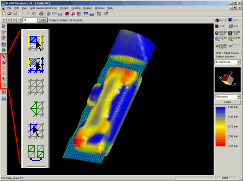

B-SIM V2.5 Reference - Blow molding simulation

Post-processing
Opening a solved project for post-processing
There are several ways how to open a project for post-processing:
- When the project is open for editing (see B-SIM Project), click on the icon with the tool tip "Open for post-processing" (the icon is located on the Solver bar on the left side of the project window). The post-processing window will be automatically created.
- To open a project directly from disk file, click on the icon with the tool tip "Open solved project (post-processing)" (the icon is located on the Shortcuts bar). In Windows File Open dialog, browse for the solved project (file extension is TFC) and click Open. The project selected will be automatically opened for post-processing.
- To open a project selected in Batch click on the button Post-process on the right side of the batch window. The project selected will be automatically opened for post-processing.
- Drag and drop it from Explorer window to B-SIM window.
- Record selection (using Post-processing record bar)
- Refinement / automatic refinement
- Saving deformed parison after pre-stretching
- Export for structural analysis
- Part weight calculation
- Cooling calculation
- Critical venting areas analysis
- 3D cuts / 3D cut data table
- Exporting video (AVI format), bitmap (BMP format), 3D VRML, HTML(VRML+scale)
- Project animation
- Project export
- Switch to Image mode
- Display of project / actual record information
- Display of grid properties
- Rotate, zoom and pan the displayed preform / parison and tools
- Display different profiles on the preform / parison
- Visualize preform / parison nodes with different boundary conditions and contact status
- Explore the preform / parison and tools at different areas
- Modify boundary conditions on sheet
- Analyze elements history
Available optimization modules
- Parison / preform thickness optimization
- Preform temperature optimization
- Preform geometry optimization (D/L)
- Extrusion control optimization
Refinement from post-processing
There are three ways of refinement in post-processing.
Manual refinement 1:
This refinement works like the refinement
of initial parison / preform in B-SIM Grid view:
Click Grid / Refine to refine the preform / parison inside a selected
rectangular area. Then move the cursor into a required position and
press and hold down the left mouse button. Move the cursor to the second
corner of the rectangle and release the mouse button. The deformed preform
/ parison is automatically refined. This method can be repeated until
the required grid density is obtained.
Manual refinement 2:
This refinement works in a different way. Elements for refinement
can be selected / unselected repeatedly using post-processing toolbar.
Elements selection:
1) Click on the icon with the tool tip "Select elements". Then move the cursor into a required position and press and hold down the left mouse button. Move the cursor to the second corner of the rectangle and release the mouse button. Elements inside the rectangle will be selected (their edges color will change to green).
2) Click on the icon with the tool tip "Select squeezed elements". This will automatically select all elements squeezed between tools.
Elements unselection:
1) Click on the icon with the tool tip "Unselect elements". Then move the cursor into a required position and press and hold down the left mouse button. Move the cursor to the second corner of the rectangle and release the mouse button. Elements inside the rectangle will be unselected (their edges color (green) will change to white).
2) Click on the icon with the tool tip "Unselect all". All elements will be unselected.
Inverting selection:
To invert selection, click on the icon with the tool tip "Invert selection".
Elements selection using picking:
Click on the icon with the tool tip "Toggle elements picking on / off". Move the cursor above an element, press Control key and click the right mouse button. The element will be selected. Also any already selected element can be unselected this way.
Refinement:
When elements for the refinement are selected, click on the icon with the tool tip "Refine selection". The selected elements of the deformed preform / parison will be automatically refined. This method can be repeated until the required grid density is obtained.
Automatic refinement:
This refinement automatically refines the most deformed elements.
Click on Grid / Automatic refinement to refine the deformed preform
/ parison . This method can also be repeated. The refined preform /
parison can be saved using command Grid / Save as *.bcs.
Saving deformed parison after pre-stretch
Pre-stretched parison can be save as B-SIM grid (BCS file type) using command Grid / Save deformed grid as BCS. The resulting file can be used in a new project as the pre-stretched parison. Regarding pre-stretching, see Process control description.
Export for structural analysis / Export for injection molding mold design
The sub-menu Grid / Export for structural analysis enables to export
thermoformed product geometry, thickness and temperature to several
formats ( DXF, IGES, Patran, Cosmos / M). The exported files can be
used for structural analysis.
Ansys Out creates two files directly
readable by ANSYS. One file exported contains geometry and thickness
profile data. The second file contains residual stresses.
DXF Out creates a text file consisting of Autocad entities called 3DFACE. Such a DXF file can be used in Autocad or other CAD packages to visualize post-processing results. The file exported does not contain any information about thickness or temperature.
IGES Out creates a text file consisting of two spline surfaces. The first surface describes upper part of the product, second spline surface gives the lower part. Distance between these two surfaces is given by thickness of a thermoformed product. Such an IGES file can be used for consecutive post-processing with other CAD packages, mainly for static analysis of blow molded product. Starting from B-SIM Version 2.5, the optimized 3D preform geometry can be exported to IGES for a direct import to 3D CAD.
Cosmos/M Out creates a file directly readable by COSMOS / M structural analysis program. The file exported contains only thickness information. Temperatures are not exported.
Patran Out creates five files - *.out, *.nod, *.tep, *.elm and *.fin in PATRAN format.
-
The file *Out describes the grid topology.
-
The file *Nod contains nodal thicknesses information.
-
The file *.tep contains nodal temperatures.
-
The file *Elm contains deformed grid elements. Every element has listed:
- Its number
- Residual stresses Sigma1, Sigma2, Sigma3 (in principal direction)
- Direction cosines (for local x and y axis)
- Extensional ratios in principal directions (lambda1, lambda2)
-
The file *Fin contains final deformed grid (reform/parison) topology - this file has the same format as *.ptn except the nodal coordinates - they correspond to the deformed grid
Starting with B-SIM V2.31, calculation of weight of selected areas of deformed grid (parison / preform) is possible. This feature offers much more straightforward way to analyze the final product properties than the old Trim line feature. A short example how to use this feature can be found here.
Having a solved project open for post-processing, use the toolbar on the left side of the post-processing window to select element to be included in weight calculation.
 |
The first
button enables to select a rectangular area of elements, the second
button enables to unselect elements within rectangular area. Third
button unselects all. The fourth button selects all squeezed elements
(usefull for extrusion blow molding). The fifth button toggles
element picking on and off. The last button inverts the selection. |
How to select elements:
Elements selection:
1) Click on the icon with the tool tip "Select elements". Then move the cursor into a required position and press and hold down the left mouse button. Move the cursor to the second corner of the rectangle and release the mouse button. Elements inside the rectangle will be selected (their edges color will change to green).
2) Click on the icon with the tool tip "Select squeezed elements". This will automatically select all elements squeezed between tools.
Elements unselection:
1) Click on the icon with the tool tip "Unselect elements". Then move the cursor into a required position and press and hold down the left mouse button. Move the cursor to the second corner of the rectangle and release the mouse button. Elements inside the rectangle will be unselected (their edges color (green) will change to white).
2) Click on the icon with the tool tip "Unselect all". All elements will be unselected.
Inverting selection:
To invert selection, click on the icon with the tool tip "Invert selection"
Elements selection using picking:
Click on the icon with the tool tip "Toggle elements picking on / off". Move the cursor above an element, press Control key and click the right mouse button. The element will be selected. Also any already selected element can be unselected this way.
Having elements selected, click on Grid / Properties in post-processing menu. The following window appears with details about selected area:

This window is modeless, this means you still can continue in elements selection / unselection. Imformation about volume and weight is updated automatically.
Calculation of weight using Trim line
The following commands are accessible from Grid / Trim line menu:
-
Load enables to load a trim line form *.CDL file.
-
Remove removes the trim line already projected on the deformed product.
-
Information displays information about the selected part mass and volume.
The loaded trim line is superposed onto the preform / parison and the mass of the selected part of the sheet is calculated.
-
The original trim line appears on the screen painted green.
-
The projection of the original trim line onto the deformed sheet surface is painted black.
-
The projection of the trim line onto the flat sheet surface is painted red.
Format of Trim Line file (*.CDL):
The trim line must be described as a set of points stored in CADL format
(CadKey). Units used in CADL file can be millimeters or inches (see
Configuration).
Preparing data to describe a Trim Line:
B-SIM is capable to read a set of 3D-points from files in CADL-format.
Example - How to create a trim line representation
in SURFCAM (CAD - Surface modeler):
The trim line must be one continuous NURB spline. It is necessary to
create the set of points on this spline. To do so, one has to copy the
spline into separate layer. Then select INCREMENT command in EDIT menu.
Select the spline representing the trim line. Fill the dialog like this:
-
How many sections? 199
-
Break the original? No
-
Points at breaks? Yes
-
Coords between breaks? No
-
Click ACCEPT.
Then the points representing the trim line are created. Now go to FILE menu and click CADL. Then select WRITE. Enter a filename to save the data. Remark: When exporting to CADL, only the layer containing the set of points representing the trim line should be active.
In B-SIM: Open a solved project in post-processing. Select command Load trim line from Grid / Trim line menu. Enter the name of the CADL file previously created in SurfCam. The trim line is loaded and volume etc. of the selected part is calculated.
Format of CADL file containing Trim Line data:
Each line in the file looks like this: POINT 10.0, 0.0, 0.0 ... (POINT
is a keyword saying that the three following coordinates represent a
3-D point.)
Number of points is not restricted.
Example:
(Trim Line File list - the first point has to be the same as the last
one)
POINT 0,0,0,15,0,0,0,0
POINT 50,0,0,15,0,0,0,0
POINT 50,20,0,15,0,0,0,0
POINT 50,20,20,15,0,0,0,0
POINT 0,20,20,15,0,0,0,0
POINT 0,20,0,15,0,0,0,0
POINT 0,0,0,15,0,0,0,0
(Resulting Trim Line)

When in post processing, use command Cooling / Calculate cooling (located on Post processing toolbar) to calculate the blow molded part cooling.
Remark: The cooling calculation is possible only when the project was
completely solved using B-SIM Version 2.1 or later.
After clicking the command specify the cooling time and click OK.
The cooling calculation starts immediately. The temperature map on the
formed product is changing as the grid (sheet) is cooling down. Once
the calculation is finished (the cooling time is reached), the deformed
grid (sheet) has the final cooled temperature profile.
Remark: During the cooling calculation, the temperature scale has fixed
limits. To get scale with real temperature minimum and maximum after
the calculation, click on Limits button on the Scale
bar and select Automatic in the Limits group.
3D cuts
To create the 3D Cut view, use Grid / Cut window command in post-processing.

Use the Make cut button to make a cut on the deformed preform / parison. Making a cut:
-
Make sure the option Cut Def. (Cut definition) is checked.
-
Specify the Cut plane by selecting X, Y, Z = or 3 points.
-
Option X, Y, Z =: Select X=, Y= or Z= and entering the plane distance from the point [0,0,0].
-
Option 3 points: Press the Pick button and then pick three points on the grid(sheet) using Control (Ctrl) key + Right mouse button click.
-
Select the required Profile.
Once the cut is created, the correspondence between the 2D cut graph and the original 3D picture can be easily found when placing the mouse cursor to the area of 2D curve of thickness(temperature, stress or extension) / arc length. After pressing and keeping pressed the left mouse button, the vertical line appears on the graph and the double lined cross in the 3D picture. When moving the cursor, the cross moves in the 3D space, thus giving a track of a desired position both in 2D and 3D. The window with the graph can be moved or resized so that it does not hide the area of interest in the 3D picture. To modify the graph limits, click on Limits. Use the [T] button to force the cut window to remain on the top. When the button is pressed, the cut window remain on the top. It is possible to print out the cut graph - use Print command from Cut menu.
3D cut data table
Click on Cut / Cut data table when B-SIM Cut view is active to display
the following dialog:

This dialog contains data of a cut created from 3D cut view. In Distance between cut points specify a positive value in mm / inch and press Enter key or click on Regenerate cut points. Cut points will be recalculated. To include 3D coordinates of the cut points into the cut data, check Include 3D cut points coords. Click on Copy to clipboard to copy the cut data into clipboard. These data stored in clipboard can be used for transfer into MS Excel etc. Click Close to close the dialog.
Export - video, bitmap, VRML, HTML + VRML
Display / Export / Video
This command creates AVI (Audio-Video-Interleaved) file - animation
of post-processing results. This file can be played using MediaPlayer
distributed with Windows NT 4.0/ Windows 95. (Start / Programs / Accessories
/ Multimedia / Media Player)
Display / Export / Bitmap
This command creates BMP file - a bitmap with post-processing results.
After selecting it, specify a file name to save the picture into. Then
specify required bitmap resolution an click OK. 24-bit bitmap is created
and saved under the specified name.
Display / Export / VRML
This command creates VRML file - a 3D representation of the actual post-processing
results. After selecting it, specify a file name to save the VRML data
into and click OK. VRML file is created automatically. A VRML viewer
is necessary to open the VRML file.
Display / Export / HTML (VRML+scale)
This command creates HTML file containing embeded VRML model and PNG color
scale of the actual post-processing results. After selecting it, specify a
file name to save the HTML code into and click OK. HTML file is created with
the specified name is created. Moreover, a VRML file with the same name as
the HTML file, but with extension "wrl" is created, containing 3D
VRML model data of the deformed sheet. The corresponding variable color scale
is saved into a PNG file, having also the same name as the HTML (with extension
PNG). Any existing HTML / VRML / PNG file(s) are overwritten.
The created HTML file can be opened in any HTML browser. A 3D VRML viewer plug-in has to be installed in order to display the VRML model on HTML page. On this page, a list of VRML viewers is available. Accuform recommends the following VRML viewers: CosmoPlayer and WorldView.
Animation
Command Display / Animation runs and stops
animation of post-processing results.
Project export
This very useful feature enables the B-SIM user to exchange results.
The exported files keep all the information needed to rerun a project,
no additional information is needed. After exporting results, the files
can be compressed and sent as an attachment to E-mail message. It became
an important and very efficient tool in supporting B-SIM customers worldwide.
(It is not necessary to export all the files, namely the calculated
(*.000, *.001, *.0..). They are usually too big to be sent via Internet.
As a default, they are excluded from the exporting routine. If you wish
to export also result files, simply uncheck Export only source project
files. Moreover, it is possible to export just first and last records
- just check Export FL …). In post-processing, click Project /
Export results. The following dialog appears:

In Export to folder enter a folder name or use Browse button to browse
for a folder to export the projects files into. If the specified folder
does not exists the program will offer to the user to create one of
this name. Click Export to export all project files into the specified
folder. Click Close to close the export dialog.
Project information / Record information
Project information
With a B-SIM project open for post processing, click on Project
/ Project info to display the following information box:

It gives information about the files used in project, job number, number
and programmer.
Remark: To access the source project directly (to open any of the project
files etc.), click on Project / Open source project file.
Record information
With a B-SIM project open for post processing, click on Project
/ Record info to display the following information box:

It gives information about the active record number, inflated grid
outer box dimensions, the time of the process until the active record,
the pressure achieved and the inflated volume. The average thickness
value is calculated from the grid elements which are not clamped.
Thickness non-uniformity factor is defined below.
Thickness non-uniformity factor: ![]()
Average thickness: ![]()
S … deformed preform/parison area
se … deformed element area
te … deformed element thickness
With a B-SIM project open for post processing, click on Grid / Properties to display the following information box:

It gives information about the number of elements (triangles), the dimensions of the deformed grid, mean thickness (for the whole grid and for the grid excluding clamped elements) and mean temperature.
Parison / preform thickness optimization
B-SIM is capable to automatically optimize the initial parison / preform thickness in order to get uniform thickness distribution on a final product. First, open a solved project for post-processing. Now, select the command Optimizations / Optimize thickness. B-SIM creates a new subdirectory "OptimThickness" and in this directory, new optimization projects are automatically generated. Once B-SIM is prepared to start the optimization, the following message box appears together with the optimization batch view:

Now click OK to start the optimization batch solution. Another message box asking for confirmation appears. Click Yes and the optimization will start. Ten optimization projects will be solved to get the optimized initial parison / preform thickness profile. Please wait until the optimization batch is solved. This can take a long time, especially in case the solution of the initial project took hours. Once the optimization is finished:
-
To see the optimization result, open the last project in the optimization batch view (in this case Project9.tff) - just click on Post process button.
-
To see the optimized initial thickness profile, select the first record using post-processing record bar.
The optimized preform (injection blow molding process) can be exported to IGES for further CAD work (Injection molding mold desing).
Preform temperature optimization
B-SIM is capable to automatically optimize the initial preform temperature in order to get uniform thickness distribution on a final product. First, open a solved project for post-processing. Now, select the command Optimizations / Optimize temperature. B-SIM creates a new subdirectory "OptimTemperature" and in this directory, new optimization projects are automatically generated.
-
To see the optimization result, open the last project in the optimization batch view (in this case Project9.tff) - just click on Post process button.
-
To see the optimized initial temperature profile, select the first record using post-processing record bar.
B-SIM is capable to automatically optimize the initial preform length in order to get uniform thickness distribution on a final product. First, open a solved project for post-processing. Now, select the command Optimizations / Optimize preform (L/D). The following dialog appears:

Enter minimum and maximum for the preform length and number of optimization points. in this case, 5 projects are created, with preform having length 100, 110, 120, 130 and 140 mm. Click OK.
Once the optimization is finished, B-SIM displays a message about the result. in B-SIM Messages bar, there is a detailed info about the final thickness distribution for all the simulated projects:

Red color: The area is not on mold wall
Yellow color: The area is just touching mold wall
Blue color:: The area lays on mold wall
Add clamping
Remove clamping
Add "no pressure" flag
Remove"no pressure" flag
